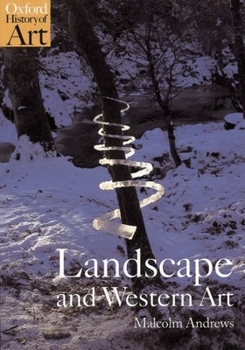Landscape and Western Art
Select Format
Select Condition 
Book Overview
What is landscape? How does it differ from "land?" Does landscape always imply something to be pictured, a scene? When and why did we begin to cherish images of nature? What is "nature?" Is it everything that isn't art, or artifact? By addressing these and many other questions, Landscape and Western Art explores the myriad ideas and images of the natural world in Western art since the Renaissance. Implying that land is the raw material, and...
Format:Paperback
Language:English
ISBN:0192842331
ISBN13:9780192842336
Release Date:February 2000
Publisher:Oxford University Press, USA
Length:256 Pages
Weight:1.38 lbs.
Dimensions:0.6" x 6.5" x 9.2"
Customer Reviews
2 ratings
Thought provoking
Published by Thriftbooks.com User , 14 years ago
This book is an thought provoking continuation of the 1962 discussion on "landscape art" that art historian Kenneth Clark introduced in his pioneering work "Landscape into Art". This is NOT an easy read nor "the history of landscape" as the title suggests but rather a discussion of key themes in landscape art such as landscape as cultural construct, political catalyst, topography, and practices of "framing the view" appropriate for those educated in art history. The many wonderful but small reproductions serve to illustrate the concepts presented throughout the text.
Excellent Smart Study
Published by Thriftbooks.com User , 16 years ago
This book faces two usually insurmountable hurdles - first, designing an art book in a smallish size, with the corresponding destruction of anything like a scale appreciation for larger images true size; and second, covering an enormous amount of material in a very short text. The first remains an indefensible decision, and there's no more to be said. As for the second hurdle, Andrews does a fine job of what baseball pitchers refer to when they wiggle out of endless bases loaded situations without giving up a run - walking between the raindrops. This scholarly act of prestidigatation calls for hearty applause - usually such surveys are either too careful or too general. Happily this book is neither, but rather thought-provoking and sagacious. Andrews success seems to lie in an acquired acceptance that for all the modern kitchen sink tools applied to art history - from Levi-Straussian anthropology to historical statistical anaylysis to Foucault's deconstructionist revisionism, there remains an abiding need for aesthetic appreciation. As one reads through the book, a sort of moderated mediatation or commentary on what is landscape, how we see it, a large array of such new thinking pops up, many contemporary responses about the nature of landscape are offered. Yet in the end Andrews falls back, and rather slyly I might add, on a sort of updated aestheticism. The distinction, and the difference Andrews makes with this old tool is surprising. The material comes across with a clarity and directedness absent from the more typical contemporary approaches to art, approaches emphasizing far more than the works of art, usually at the expense of shrinking down their full import in a maze of dubious cross-referencing. Andrews greatest gift is confidence - he conveys a supreme sureness whatever he is writing about. In an age of relative values Andrews' certainty reverberates with an insolent disdain for doubt. (I am reminded of one critic's snickering potshot at A.L. Rowse's offhand dismissal of alternate Shakepeare author theories as pure nonsense - "for Rowse, doubt is an undiscovered country.") But Andrews, for all of that, is very much the modern, quite up on the various formalized readings and professional jargon. He has taken the measure of each of these chimeras and gone back to draw his own conclusions around an aesthetic largely free of post-modern cant. For Andrews the modern critical methodologies are but tools, used when needed, and not self-indulgence repudiating the reader in deliberately obtuse and hermetic language. And a huge bonus - Andrews is fun to read, displaying an extraordinarily adept mind; his questions and examples rarely failing to not only make his point, but develop it. Having showered the author with praise I must point out one caveat: unlike Kenneth Clarke, who invariably seemed to put his figure on the one painting defining an age or movement, Andrews sometimes misses the obvious. A discussion o




